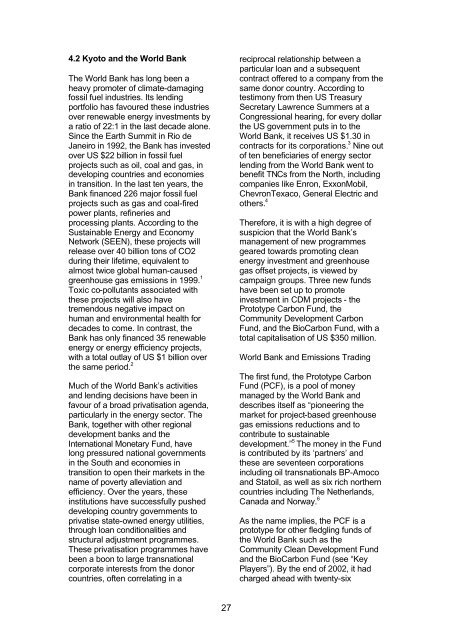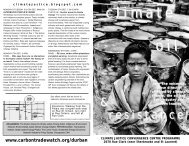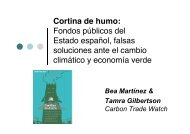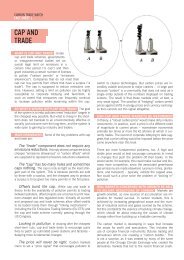The Sky is Not the Limit: - Carbon Trade Watch
The Sky is Not the Limit: - Carbon Trade Watch
The Sky is Not the Limit: - Carbon Trade Watch
- No tags were found...
You also want an ePaper? Increase the reach of your titles
YUMPU automatically turns print PDFs into web optimized ePapers that Google loves.
4.2 Kyoto and <strong>the</strong> World Bank<strong>The</strong> World Bank has long been aheavy promoter of climate-damagingfossil fuel industries. Its lendingportfolio has favoured <strong>the</strong>se industriesover renewable energy investments bya ratio of 22:1 in <strong>the</strong> last decade alone.Since <strong>the</strong> Earth Summit in Rio deJaneiro in 1992, <strong>the</strong> Bank has investedover US $22 billion in fossil fuelprojects such as oil, coal and gas, indeveloping countries and economiesin transition. In <strong>the</strong> last ten years, <strong>the</strong>Bank financed 226 major fossil fuelprojects such as gas and coal-firedpower plants, refineries andprocessing plants. According to <strong>the</strong>Sustainable Energy and EconomyNetwork (SEEN), <strong>the</strong>se projects willrelease over 40 billion tons of CO2during <strong>the</strong>ir lifetime, equivalent toalmost twice global human-causedgreenhouse gas em<strong>is</strong>sions in 1999. 1Toxic co-pollutants associated with<strong>the</strong>se projects will also havetremendous negative impact onhuman and environmental health fordecades to come. In contrast, <strong>the</strong>Bank has only financed 35 renewableenergy or energy efficiency projects,with a total outlay of US $1 billion over<strong>the</strong> same period. 2Much of <strong>the</strong> World Bank’s activitiesand lending dec<strong>is</strong>ions have been infavour of a broad privat<strong>is</strong>ation agenda,particularly in <strong>the</strong> energy sector. <strong>The</strong>Bank, toge<strong>the</strong>r with o<strong>the</strong>r regionaldevelopment banks and <strong>the</strong>International Monetary Fund, havelong pressured national governmentsin <strong>the</strong> South and economies intransition to open <strong>the</strong>ir markets in <strong>the</strong>name of poverty alleviation andefficiency. Over <strong>the</strong> years, <strong>the</strong>seinstitutions have successfully pusheddeveloping country governments toprivat<strong>is</strong>e state-owned energy utilities,through loan conditionalities andstructural adjustment programmes.<strong>The</strong>se privat<strong>is</strong>ation programmes havebeen a boon to large transnationalcorporate interests from <strong>the</strong> donorcountries, often correlating in areciprocal relationship between aparticular loan and a subsequentcontract offered to a company from <strong>the</strong>same donor country. According totestimony from <strong>the</strong>n US TreasurySecretary Lawrence Summers at aCongressional hearing, for every dollar<strong>the</strong> US government puts in to <strong>the</strong>World Bank, it receives US $1.30 incontracts for its corporations. 3 Nine outof ten beneficiaries of energy sectorlending from <strong>the</strong> World Bank went tobenefit TNCs from <strong>the</strong> North, includingcompanies like Enron, ExxonMobil,ChevronTexaco, General Electric ando<strong>the</strong>rs. 4<strong>The</strong>refore, it <strong>is</strong> with a high degree ofsuspicion that <strong>the</strong> World Bank’smanagement of new programmesgeared towards promoting cleanenergy investment and greenhousegas offset projects, <strong>is</strong> viewed bycampaign groups. Three new fundshave been set up to promoteinvestment in CDM projects - <strong>the</strong>Prototype <strong>Carbon</strong> Fund, <strong>the</strong>Community Development <strong>Carbon</strong>Fund, and <strong>the</strong> Bio<strong>Carbon</strong> Fund, with atotal capital<strong>is</strong>ation of US $350 million.World Bank and Em<strong>is</strong>sions Trading<strong>The</strong> first fund, <strong>the</strong> Prototype <strong>Carbon</strong>Fund (PCF), <strong>is</strong> a pool of moneymanaged by <strong>the</strong> World Bank anddescribes itself as “pioneering <strong>the</strong>market for project-based greenhousegas em<strong>is</strong>sions reductions and tocontribute to sustainabledevelopment.” 5 <strong>The</strong> money in <strong>the</strong> Fund<strong>is</strong> contributed by its ‘partners’ and<strong>the</strong>se are seventeen corporationsincluding oil transnationals BP-Amocoand Statoil, as well as six rich nor<strong>the</strong>rncountries including <strong>The</strong> Ne<strong>the</strong>rlands,Canada and Norway. 6As <strong>the</strong> name implies, <strong>the</strong> PCF <strong>is</strong> aprototype for o<strong>the</strong>r fledgling funds of<strong>the</strong> World Bank such as <strong>the</strong>Community Clean Development Fundand <strong>the</strong> Bio<strong>Carbon</strong> Fund (see “KeyPlayers”). By <strong>the</strong> end of 2002, it hadcharged ahead with twenty-six27











